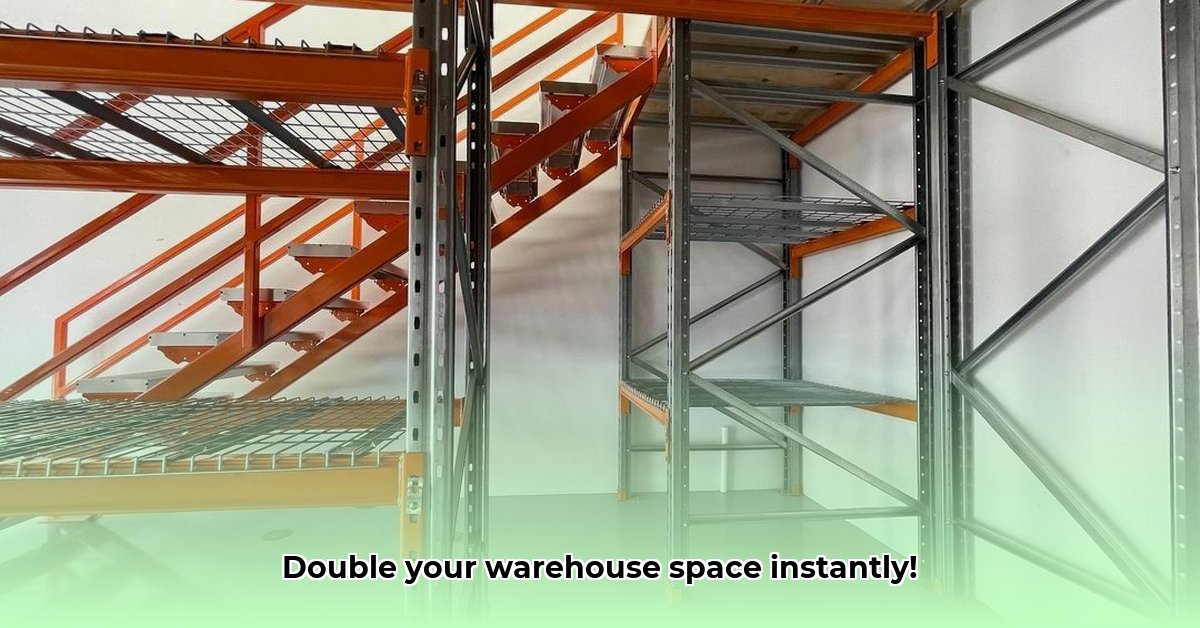Running out of room in your warehouse and seeing storage costs skyrocket? Rack-supported mezzanines might be your solution. This guide shows you how these systems can dramatically increase your storage space and make your warehouse run more smoothly. We’ll walk you through planning and installing a mezzanine, comparing it to other options, and showing you how to keep it safe and efficient for years to come. We’ll even cover design tips so your mezzanine works perfectly now and adapts as your business grows. For more info on mezzanines, check out this helpful resource: [Mezzanine Floors Explained](https://www.wavesold.com/what-is-a-mezzanine-floor). Get ready to put that unused vertical space to work and supercharge your warehouse!
Rack Supported Mezzanine: Your Warehouse’s Extra Floor
Let’s talk about maximizing your warehouse space without breaking the bank or moving locations. A rack-supported mezzanine is like adding a second story to your warehouse, but using your existing racking system as the foundation. It’s a surprisingly simple yet effective way to dramatically boost your storage capacity. Think of it as a clever way to “stack” your inventory vertically, getting more bang for your warehouse buck. Let’s explore how rack-supported mezzanines offer efficient vertical storage solutions for modern warehouses, improving operational workflows and boosting storage capacity.
Understanding Rack Supported Mezzanines: More Than Just Extra Shelves
Imagine a platform built on top of your existing warehouse racking; that’s essentially a rack-supported mezzanine. It’s not just extra shelves; it’s a whole extra floor! Key components include the strong steel racking that supports the entire structure, the platform itself (often made of steel or sturdy wood), stairs or lifts for access, safety railings to prevent accidents, and possibly even conveyors or other material handling systems integrated right into the design. Different types of mezzanines exist, so you can find one that fits your warehouse layout perfectly, whether it’s long and narrow, or wide and open.
The Upsides and Downsides: Weighing the Pros and Cons
Before diving in, let’s honestly look at the good and the not-so-good. Rack-supported mezzanines offer many advantages, but like any solution, there are factors to consider. What key considerations should guide your choice when evaluating the benefits and constraints and determining where rack-supported mezzanines can meet your warehouse objectives?
Advantages:
- Massive Storage Increase: You’ll likely double, or even triple, your storage space without needing a bigger building. This is a big win for growing businesses looking to scale operations within their current footprint.
- Smart Space Use: You’re making the most of your existing vertical space, which is incredibly efficient. You’re not just adding space; you’re optimizing the space you already have, reducing the need for expansion or relocation.
- Smooth Operations: A well-planned mezzanine can greatly improve your warehouse workflow, simplifying inventory management and order fulfillment. Everything’s more accessible and organized, leading to faster turnaround times and reduced errors.
- Cost-Effective Solution: Compared to constructing a new building or leasing additional warehouse space, rack-supported mezzanines represent a significant cost saving. The modular design also minimizes installation time and disruption to existing operations.
- Adaptability and Flexibility: These mezzanines can be easily reconfigured or expanded as your business needs evolve. This adaptability ensures that your storage solution remains relevant and efficient over the long term.
Disadvantages:
- Careful Planning: A successful mezzanine implementation requires careful planning and a thorough site survey by experts. This ensures the structure is stable, safe, and compliant with all relevant building codes and regulations.
- Weight Limits: There are limits to how much weight the mezzanine can support. You need to carefully consider the weight of the materials you’ll be storing and ensure the structure is rated for that load. Exceeding these limits could compromise the structural integrity of the mezzanine and pose a safety risk.
- Maintenance is Key: Like any structure, regular inspection and maintenance are vital to ensure its long-term safety and durability. This includes checking for damage, corrosion, and loose connections, and ensuring that safety features are in good working order. Neglecting maintenance can lead to costly repairs and potential accidents.
- Potential for Obstruction: Depending on the design and layout, a mezzanine can potentially obstruct natural light or interfere with existing sprinkler systems. Careful planning is needed to mitigate these issues and ensure a comfortable and safe working environment.
- Accessibility Considerations: While mezzanines increase storage space, they may also pose accessibility challenges for employees with mobility limitations. Consider incorporating ramps or lifts to ensure that all areas of the warehouse are accessible to everyone.
Planning and Installing Your Rack Supported Mezzanine: A Step-by-Step Guide
Installing a mezzanine isn’t a DIY project; it requires professionals. Here’s what the process usually involves:
Step 1: Assessing Your Needs: Before anything else, determine exactly what you need to store, how much it weighs individually and collectively, and the volume of materials involved. Consider seasonal fluctuations and future growth projections to ensure the mezzanine meets your long-term storage requirements.
Step 2: On-Site Evaluation: A qualified structural engineer will conduct a thorough site survey to assess your existing racking system, confirm its structural integrity, and determine if it can safely support the added weight of the mezzanine. They will also evaluate floor load-bearing capacity and identify any potential obstacles or challenges.
Step 3: Choosing the Right Partner: Get quotes from several reputable mezzanine suppliers. Don’t just compare prices; compare experience, reputation, the warranty offered, and their ability to provide comprehensive support from design to installation. Check their certifications and ensure they comply with industry standards. Read online reviews or talk to other businesses that have used their services.
Step 4: Design and Engineering: Work closely with the vendor and the engineer to finalize the mezzanine’s design. This includes determining the size, load capacity, access points (stairs, lifts, etc.), and safety features. Optimize the layout for efficient material flow and consider incorporating features such as lighting, ventilation, and fire suppression systems. Secure any necessary building permits during this stage.
Step 5: Installation and Supervision: Professional installation is non-negotiable. Make sure the installation is overseen by a qualified supervisor to guarantee adherence to safety protocols and building codes. The installation team should have experience working with rack-supported mezzanines and be committed to minimizing disruption to your warehouse operations.
Step 6: Post-Installation Check: Once installed, a final inspection confirms everything meets the plans and regulations. This inspection should be conducted by both the installer and a third-party inspector to ensure impartiality. Only then is the mezzanine ready for use.
Safety First: Maintaining Your Mezzanine Investment
Safety should be paramount throughout the entire process, from design to installation and ongoing maintenance. Here are some key safety considerations:
- Fall Protection: Strong guardrails and safety gates are essential to prevent falls from the mezzanine level. Ensure that these safety features meet or exceed all applicable safety standards and regulations.
- Fire Safety: Use fire-resistant materials for the decking and ensure adequate fire suppression systems are in place. Consult with a fire safety expert to determine the appropriate type and placement of fire extinguishers, sprinklers, and other fire safety equipment.
- Emergency Exits: Clear and easily accessible emergency exits must be incorporated into the design. These exits should be clearly marked and well-lit, and employees should be trained on emergency evacuation procedures.
- Regular Inspections: Develop a regular inspection schedule to proactively identify and address any potential issues before they become serious problems. This could include checking for structural damage, wear and tear, and the functionality of safety equipment. Keep a detailed log of all inspections and maintenance activities.
- Load Capacity Awareness: Clearly display the mezzanine’s load capacity in multiple locations and train employees on the importance of adhering to these limits. Implement procedures to prevent overloading and ensure that materials are evenly distributed across the mezzanine floor.
- Proper Lighting: Adequate lighting is essential for safe operation on the mezzanine. Ensure that all areas are well-lit and that lighting fixtures are properly maintained.
Real-World Success: A Case Study (Example)
A local manufacturing company, Acme Industries, used a rack-supported mezzanine to solve a significant storage challenge, increasing their storage capacity by 60%. This allowed them to streamline operations, reduce handling costs by 25%, and avoid the expense of relocating to a larger facility. The improved utilization of their existing warehouse space resulted in a measurable increase in their bottom line, with a reported ROI of 18 months. Acme Industries also reported improved employee morale due to a more organized and efficient workspace.
Moving Forward: Your Next Steps
Adding a rack-supported mezzanine can significantly improve your warehouse efficiency and storage capacity. Remember, thorough planning, professional installation, and ongoing maintenance are crucial for a successful and safe implementation. Consult with industry experts to determine the best solution for your specific needs. The investment in careful planning will pay off greatly in the long run. Consider getting multiple quotes and visiting existing mezzanine installations to get a better understanding of the process and the potential benefits.
How to Calculate Load Bearing Capacity for Rack Supported Mezzanines
When designing rack-supported mezzanines, precisely estimating the load-bearing capacity is critical to safety and compliance; what precise processes are required to ensure the long-term reliability and structural soundness of your mezzanine?
Key Takeaways:
- Accurate load calculations are crucial for safety and compliance, preventing structural failures and ensuring the safety of personnel and stored materials.
- Both dead and live loads must be considered, and these calculations
- Glass Tile Shower Ideas to Create a Stunning Bathroom Space - December 7, 2025
- Glass Wall Tile Ideas for Kitchens and Bathrooms - December 6, 2025
- Glass Tile Bathroom: Create a Beautiful, Easy-Clean Space - December 5, 2025










